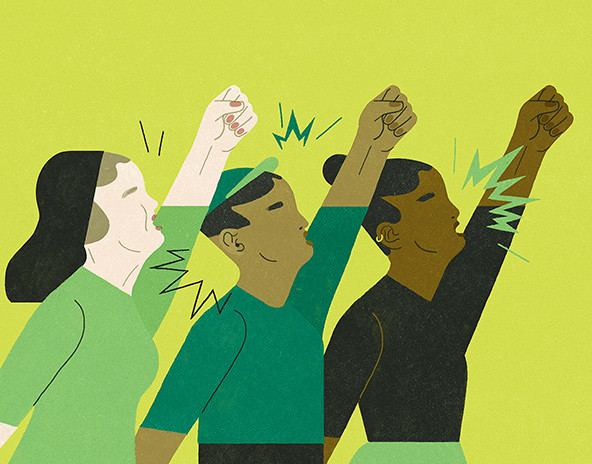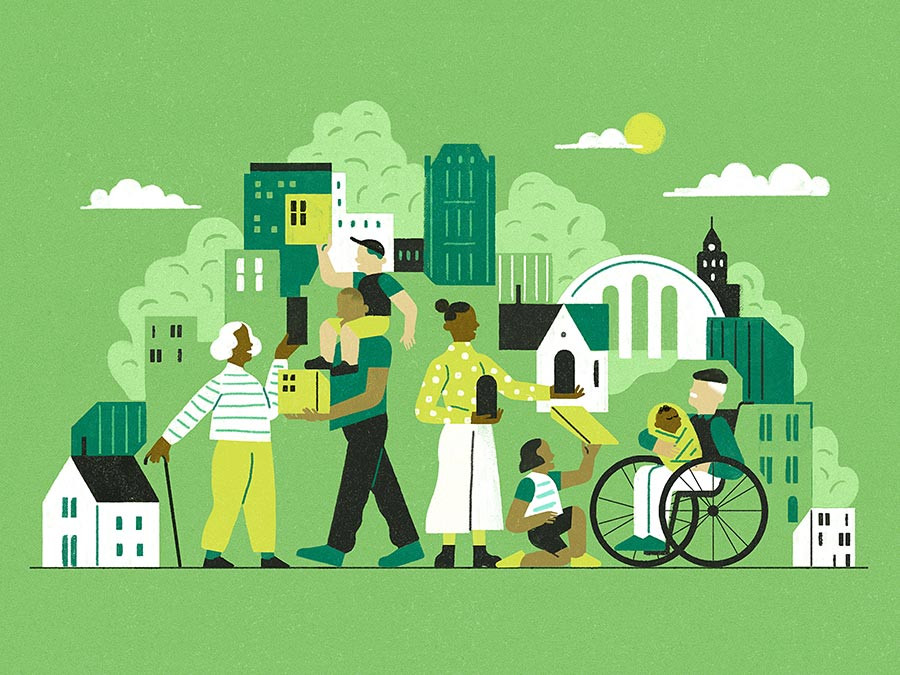 (Illustration by Gracia Lam)
(Illustration by Gracia Lam)
As the crises of climate change, racism, and economic inequality coalesce, many young activists are aware that even the most ambitious policy changes won’t, on their own, achieve a sustainable future. These times require a cultural shift away from limitless extraction and consumption. The call to heal our planet and dismantle white supremacy is, above all, a call to evolve and grow our souls.
That’s a perplexing task, especially for the most religiously unaffiliated generation in the United States. When asked, about 44 percent of millennials, who are 25 to 40 years old, check “none of the above” from a list of religious affiliations. This has earned them the nickname “the nones” at our organization, Nuns and Nones—a coalition seeking to create communities of care and contemplation that incite bold social action.

Millennials and younger generations who are separated from religious institutions lose a wealth of benefits, including organized community, moral backing, and brick-and-mortar spaces that have historically fueled social change. Consider, for example, the Black church’s central role in the civil rights movement. Today’s young activists who lack religious or spiritual support structures are making it up as they go—often in isolation.
Creating a New Community
At the same time, Catholic nuns—often called women religious or sisters—have spent their lives in a spiritual community to sustain a lifetime of service to the poor and marginalized. Following the Catholic church’s renewal movement in the 1960s and 1970s, most sisters shed their traditional habits and cloistered lifestyle, and began serving where they perceived the greatest need, while continuing to live with one another in community. Their work at present-day ministries includes advocating for LGBTQ rights, providing legal counsel to immigrants, running ecojustice farms, and protesting the construction of fossil fuel pipelines.
Yet today’s Catholic sisters face a challenge. In the United States, there are about 30,000 Catholic sisters, or one quarter of the number there were in the late 1960s, and their average age is 80 years old. With many fewer women becoming nuns, these communities are searching for new, creative ways to share their way of life.
To the outsider, an affiliation between young, spiritually diverse activists and Catholic sisters may seem unlikely, even odd. But during a few organized exchanges between about 20 young activists and older sisters in 2016, the two groups recognized that they shared a similar impulse to integrate personal transformation with the lifelong work of pursuing social and ecological justice. Their conversations led to the formation of Nuns and Nones.
Our initial exchanges sparked a network of twelve local groups throughout the United States, in locations such as Boston; Chicago; Grand Rapids, Michigan; Minneapolis, Minnesota; Pittsburgh, Pennsylvania; Washington, DC; and the San Francisco Bay Area. Local organizers hold ongoing meetups, dialogue circles, retreats, and movement organizing events.
Blending Community, Contemplation, and Social Action
At Nuns and Nones, we seek to create “bridge infrastructure” that allows ideas and resources to flow freely between generations and across religions. We envision a world in which young activists have access to a model for contemplative living, and sisters are supported in imagining futures for their way of life—both inside and outside of religious institutions.
Our national network also continues to experiment with new programs that blend community, contemplation, and action. In 2019, for example, five nones—which we also call seekers—moved in with the Sisters of Mercy in Burlingame, California, for six months as part of a pilot residency program. A different program brought together more than 200 sisters and seekers to take an online course on the regenerative economy and discuss how to move beyond economic practices that value profit over people and the planet. And last fall, hundreds of people from our network joined together to get out the vote and keep voters safe during the presidential election.
We aren’t working alone. An emerging network of national groups is emerging to serve social activists’ need for spiritual community outside religious institutions. The Formation Project, for example, designed a year-long, modern adaptation of the novitiate—the training and preparation sisters undergo before taking final vows. The Mystic Soul Project is a community created for and by people of color to explore activism, healing, and spirituality. And the Faith Matters Network’s Movement Chaplaincy training program offers spiritual support to people engaged in social justice movements.
Over the past five years, we’ve seen many powerful benefits to combining spiritual community and social justice activism across generations. Here’s a look at four:
1. Nourishing and Sustaining Lifelong Commitment to Social Justice
Throughout history, spiritual communities have upheld and reinforced social justice movements. The Quakers, for instance, played a major role in the abolitionist movement in the 18th and 19th centuries. And in the 20th century, Mahatma Gandhi relied on his deep Hindu beliefs and practices to sustain the nonviolent campaign for India’s independence.
Sisters and seekers share an impulse for a counter-cultural lifestyle, fueled by spiritual longings and justice work. For sisters, these elements are much more structured; they include lifelong vows, a faith tradition, and the radical commitment to share their income, expenses, and belongings.
Through decades of contemplative practice and community life, sisters bring a rootedness to movement spaces that young activists desire but often lack. “I think spiritual life allows you to live and have staying power in places where hard things can burn you out,” said Michigan-based organizer Kendra Avila. “When you are doing it with others in community, struggling with the same questions … it helps you stay a little bit longer.”
Sisters and seekers in Avila’s group have held podcast discussions and postcard-writing parties to support migrant families at the border. In Minneapolis, members are reading articles about ecological justice between work sessions on sisters’ community gardens. And members in the San Francisco Bay Area are exploring new forms of community in a variety of ways, including taking a field trip to the urban farm and education center Canticle Farm, which seeks to “transform trauma across differences” of race, gender, and age.
Often, one encounter sparks bigger experiments. At the outset of COVID-19, for example, the New York City group’s Zoom meetups inspired the Dominican Sisters of Hope to offer hour-long listening sessions to the public. The sessions have run for 53 ongoing weeks since the outset of the pandemic, drawing in 270 sisters and seekers of all ages to “hold one another” as they share thoughts, struggles, and experiences.
2. Building Mutually Beneficial Relationships
Intergenerational alliances are most effective when they are mutually beneficial, as other essays in this series have discussed. At Nuns and Nones, we aim to engage both sisters and seekers in a shared process of creation.
For example, a team of four sisters, five seekers, and the director of Mercy Center joined in a months-long collaborative process to design the aforementioned pilot residency program and propose it to the sisters living at the Mercy Convent. Once the young residents moved in, the same group met regularly to plan events for the broader community, including discussions on topics like gender and sexuality, and weekly ice-cream socials with the community’s eldest sisters. They also took to the streets to protest the separation of migrant families at the border. The residents, several of whom were Jewish or had ties to Judaism, also hosted a weekly Shabbat dinner that was open to their Catholic peers. In addition, sisters regularly dropped off poems or articles for the residents to read, and one even began giving viola lessons.
Through the day-to-day rhythms, residents got a glimpse of the inner workings of community life, from morning meditation to laundry protocols. At the residency’s end, Nuns and Nones co-founder Adam Horowitz said, “The lived taste of being in community across age and faith traditions makes me even more keen to orient my life toward making it manifest more often and for more people.” Sister Marguerite Buchanan said that sisters felt “a renewed energy” after experiencing residents’ curiosity and enthusiasm, adding, “I experienced great hope in the future.”
3. Creating New Uses for Sacred Spaces
Social activists need brick-and-mortar spaces in which to gather, contemplate, share experiences, and chart future goals, and declining memberships in some religious communities around the United States means that new spaces for this are opening up.
Nuns and Nones groups usually gather in sisters’ convents, motherhouses, or retreat centers designed for community life and functions. As they age, many sister communities are downsizing into smaller settings or divesting from maintenance-heavy properties, leaving an uncertain future for their convents and land.
Some have taken measures to protect their land from development by creating conservation easements, selling it to conservation trusts, or reserving it for farming. Others are creating new programming that connects with the needs of a younger, more diverse crowd. For example, in 2019, Susan Classen, a member of the Sisters of Loretto in Loretto, Kentucky, began to examine the white and privileged nature of the people who use the retreat hermitages on the sisters’ property. Through conversations with Nuns and Nones and the Retreat Center Collaborative, Classen helped the Sisters of Loretto create the Mockingbird Hill House, which offers free retreat space to social justice activists.
Monasteries are one of the earliest forms of community centers, where monks in the Middle Ages would take in strangers and help the poor. Looking to the future, could it be that the places that first served as Nuns and Nones meetings might see a further renewal as these centers of community life and learning? Might we imagine affordable housing co-ops, Indigenous-stewarded natural areas, or new spiritual organizing spaces in the convents built by these committed women? We have yet to find out, but we are working with a growing number of sisters’ communities to explore how their physical assets might contribute to the ongoing need for community and sacred space.
4. Practicing Values Internally
Any group seeking to dismantle systems of oppression should guard against replicating these systems in their own organizations. Practices and policies must reflect and uphold the values of equity, trust, and relationship.
Inspired by the Sustainable Economies Law Center’s example of compensation principles “outside of the unjust market,” for example, Nuns and Nones’ team policy commits to transparent and equal pay, a living wage, better-than-average benefits, and flexible paid vacation. This aims to address the backward logic of underpay in the nonprofit industry, where the very people most affected by social inequities are the least capable of making ends meet.
Valuing all coworkers’ labor equally is one example of how proactive policies, structures, and cultural practices—when approached intentionally—can begin to create a more equitable world from the inside out. We’ve also implemented democratic, equitable practices in other internal arenas, including feedback and accountability, ongoing political education, advisory structures, conflict engagement, and seasonal, all-team “check-ins” for reflection and assessment.
Conclusion
In 1995, scientists observed the longest-known seed dormancy when a lotus sprouted after 1,300 years. Similarly, most innovations are ancient ideas looking for new soil. The real task of social innovators is to learn how to tend old seeds in new ways.
Today’s religious landscape may be changing, but the need for cross-generational communal and spiritual infrastructure will continue. Addressing the climate crisis, white supremacy, and other injustices will require responsive and resilient communities to anchor the long-term work of culture change. Linking arms across lineage and generations, nuns and nones are tending to the aspects of community that social movements need to succeed. They’re planting the ancient seeds of resilience in new soil and inviting all of us to help them grow.
Support SSIR’s coverage of cross-sector solutions to global challenges.
Help us further the reach of innovative ideas. Donate today.
Read more stories by Brittany Koteles.

